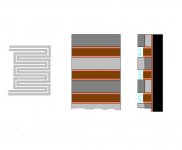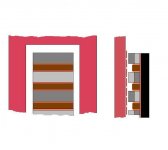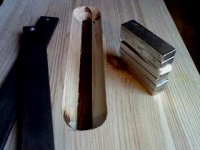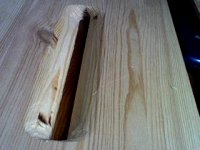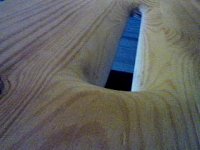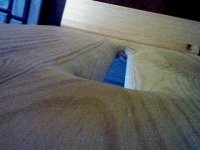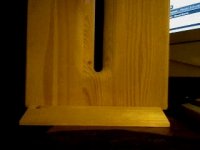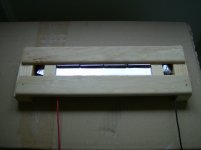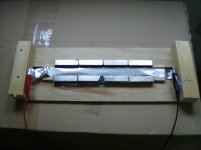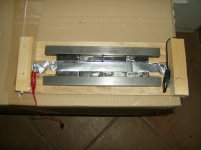With 1/2" x 1/2" x ? magnets
They are easy to find
And it doesnt matter through which side they are magnetised
Very easy to make longer
And theres none of the usual strain on the iron
And as said, no glue needed
just about any width and length is possible
Apart from the sound it will be intersting how high the sensitivity will be
They are easy to find
And it doesnt matter through which side they are magnetised
Very easy to make longer
And theres none of the usual strain on the iron
And as said, no glue needed
just about any width and length is possible
Apart from the sound it will be intersting how high the sensitivity will be
Attachments
Hi Basil
I build some small ribbons myself and this was the first problem I find.
Use some coper foil strips and as short as possible and you will be amazed.
Rob
You wires are way to thin and you will have a low pas filter.So finally i can show my DIY ribbons with non corrugated foil 😉 I have 0,65 T in the gap. I've winded the trafo to get 4ohms, it works as a super tweeter in my system . I'm very proud of it 😀
I build some small ribbons myself and this was the first problem I find.
Use some coper foil strips and as short as possible and you will be amazed.
Rob
Hi, waaayyyy back on page 5, linesource posted this formula for efficiency.
SIMPLE RIBBON EFFICIENCY EQUATIONS
A=ribbon area meter^2
B=magnetic field in Telsa
%= percent of ribbon which conducts current(100=100%)
m= mass of ribbon in grams
Efficiency = A^2 * B^2 * % / m
spl 112.2 + 10*(LOG(wfficiency)/LOG(10))
senS effeciency + LOG(8/resistance)/LOG(10)
Maybe i misunderstand, but i cant seem to make it work.
Could somebody please provide a worked example of this formula.
Maybe i;m not the only one who doesnt understand.
Thanks Tony
SIMPLE RIBBON EFFICIENCY EQUATIONS
A=ribbon area meter^2
B=magnetic field in Telsa
%= percent of ribbon which conducts current(100=100%)
m= mass of ribbon in grams
Efficiency = A^2 * B^2 * % / m
spl 112.2 + 10*(LOG(wfficiency)/LOG(10))
senS effeciency + LOG(8/resistance)/LOG(10)
Maybe i misunderstand, but i cant seem to make it work.
Could somebody please provide a worked example of this formula.
Maybe i;m not the only one who doesnt understand.
Thanks Tony
# A=ribbon area meter^2
# B=magnetic field in Telsa 1T = 10,000 Gauss
# %= percent of ribbon which conducts current(100=100%)
# m= mass of ribbon in grams
# Eff = A^2 * B^2 * % / m
# spl = 112.02 + 10*LOG(Eff) note: 112.2 is a typo
# senS = Eff + LOG(8/resistance) note: LOG(10)=1
These equations approximate the Lorentz force F = B x IL acting on the ribbon area, converted into Thiel/Small speaker efficiency and sensitivity parameters
For a 1cm = 0.01 meter wide ribbon, 1 meter long A = 0.01 meters^2
B = 1 Tesla
100% Aluminum weights 2700 kg/m3
For a 10 micron thick ribbon
m = 10E-6 meter thick * 0.01 meter wide * 1 meter long * 2700,000 g/m^3 = 0.27 grams
Efficiency = 0.01^2 meters^2 * 1^2 Tesla^2 * 100 pure aluminum ) / 0.27 grams = 0.037037
SPL = 112.02 + 10 * LOG(0.037037) = 97.7 db/ watt
Resistance for pure Aluminum = 2.65 E-8 ohms per meter^3
Resistance of ribbon is 0. 265 ohms = 1m length * 2.65E-8 / (0.01 m wide * 10E-6 m thick)
Sensitivity = efficiency + LOG(8/0.265) = 99.186 db/2.83 Volts
# B=magnetic field in Telsa 1T = 10,000 Gauss
# %= percent of ribbon which conducts current(100=100%)
# m= mass of ribbon in grams
# Eff = A^2 * B^2 * % / m
# spl = 112.02 + 10*LOG(Eff) note: 112.2 is a typo
# senS = Eff + LOG(8/resistance) note: LOG(10)=1
These equations approximate the Lorentz force F = B x IL acting on the ribbon area, converted into Thiel/Small speaker efficiency and sensitivity parameters
For a 1cm = 0.01 meter wide ribbon, 1 meter long A = 0.01 meters^2
B = 1 Tesla
100% Aluminum weights 2700 kg/m3
For a 10 micron thick ribbon
m = 10E-6 meter thick * 0.01 meter wide * 1 meter long * 2700,000 g/m^3 = 0.27 grams
Efficiency = 0.01^2 meters^2 * 1^2 Tesla^2 * 100 pure aluminum ) / 0.27 grams = 0.037037
SPL = 112.02 + 10 * LOG(0.037037) = 97.7 db/ watt
Resistance for pure Aluminum = 2.65 E-8 ohms per meter^3
Resistance of ribbon is 0. 265 ohms = 1m length * 2.65E-8 / (0.01 m wide * 10E-6 m thick)
Sensitivity = efficiency + LOG(8/0.265) = 99.186 db/2.83 Volts
Hi Linesource
Thanks for the formula examples but I can't get the last one right.
Sensitivity = efficiency + LOG(8/0.265) = 99.186 db/2.83 Volts
0.037037+LOG(30.18868)=1.516881124
Where did I go wrong?
Rob
Thanks for the formula examples but I can't get the last one right.
Sensitivity = efficiency + LOG(8/0.265) = 99.186 db/2.83 Volts
0.037037+LOG(30.18868)=1.516881124
Where did I go wrong?
Rob
# A=ribbon area meter^2
# B=magnetic field in Telsa 1T = 10,000 Gauss
# %= percent of ribbon which conducts current(100=100%)
# m= mass of ribbon in grams
# Eff = A^2 * B^2 * % / m
# spl = 112.02 + 10*LOG(Eff) note: 112.2 is a typo
# senS = Eff + LOG(8/resistance) note: LOG(10)=1
What about:
Sensitivity = Eff + 10* log (sqrt( 8 / resistance))
if we assume the use of a transformer?
(U prim / U sec) = sqrt (Z prim / Z sec)
voltage ratio (= winding ratio) is proportional to square root of the impedance ratio in a transformer, if I remember right.
Peter
Hi PW
Say you have a transformer with no loss then the SPL is the same as SPL 1W/1m 97.7dB
So I don't know what he means with the last line.
Rob
Say you have a transformer with no loss then the SPL is the same as SPL 1W/1m 97.7dB
So I don't know what he means with the last line.
Rob
The correct notation is.........Hi Linesource
Thanks for the formula examples but I can't get the last one right.
Sensitivity = efficiency + LOG(8/0.265) = 99.186 db/2.83 Volts
0.037037+LOG(30.18868)=1.516881124
Where did I go wrong?
Rob
senS = SPL + LOG(8/resistance)
My bad...I as too used to also calling the db/watt SPL the speaker efficiency
The correct notation is.........
senS = SPL + LOG(8/resistance)
My bad...I as too used to also calling the db/watt SPL the speaker efficiency
If the impedance differes by factor 2, we have a change in voltage sensitivity of 3 dB. with resistance = 4 in the above equation we have log(8/4) = 0.3, so isn't 10*log(8/resistance) the better impedance correction?
@ Rob:
better forget the rest of my above post, to much thinking about transformer winding ratios in the moment
I've been reading with great interest the information on this thread (all 55 pages 😱) - thanks to all who have contributed. One re-occuring question is where to get aluminum foil that is thin enough to be useful and I think I may have found an unlikely source. Firstly, I found a "house" brand of kitchen foil here in the States sold under the "Target" brand name. I measured it's thickness to be 0.0005" with my Mitutoyo digital caliper. Fairly thin, but maybe not thin enough. Recently, while shopping at a discount store, I came across several unknown brands of aluminum kitchen foil and noticed that one 25 sq/ft roll (12"/30.48cm wide x 8.33 yards/761.7cm long) felt unusually light so I bought a roll on a whim. When I got it home, I found that indeed it was very light - lighter than the "Target" brand plus it was too thin to measure with my digital caliper. I cannot imagine using this stuff for anything in the kitchen as it seems too thin to be of any use. I have a machinist friend that I'm going to ask to measure the foil for me and will post his findings.
I'm going to try and build a 6" maybe 8" long tweeter using this foil and will "corrigate" it with a jig that uses gears from a radio control toy car:
The big gear is 21 mm wide which should be enough for anything I plan to make.
I've already ordered some N45 magnets for this project. I'm hoping my DIY tweeter will at least come close to the Aurum Cantus G1 which uses what appears to be a 6" ribbon and is rated for a Freq. range of 900-40K Hz and a SPL of 102.0 dB 2.83V/1m with a minimum suggested x-over of 2,000 Hz.
I'm going to try and build a 6" maybe 8" long tweeter using this foil and will "corrigate" it with a jig that uses gears from a radio control toy car:
An externally hosted image should be here but it was not working when we last tested it.
Tamiya P/N 50794, (Tower Hobbies - Radio Control ( R/C or RC ) Cars, Trucks, Airplanes, Boats and Helicopters)The big gear is 21 mm wide which should be enough for anything I plan to make.
I've already ordered some N45 magnets for this project. I'm hoping my DIY tweeter will at least come close to the Aurum Cantus G1 which uses what appears to be a 6" ribbon and is rated for a Freq. range of 900-40K Hz and a SPL of 102.0 dB 2.83V/1m with a minimum suggested x-over of 2,000 Hz.
There is a relative simple way to measure the foil thickness using a ruler and a small scale.
Cut about a 1 m long 30 cm wide alu foil. Fold it and weight it using a scale with a 1 gr or better precision.
The surface S of the piece of foil is 30 x 100 = 3000 cm2
The volume V of the piece of foil is equal to its weight in gr divided by 2.7 , which is the density of aluminium.
In our example, the weight is 8 gr.
The volume V is then 8/2.7 = 3 cm3.
We have now V and S. The thickness is then V/S: 3 / 3000 = 0.001 cm = 0.00001 m = 10 microns
When I was in the US, I bought foil at different places. The thinner alu foil I found was at the dollar store (brand was "Utra foil"). Thickness was about 9 to 10 microns.
Bruno
Cut about a 1 m long 30 cm wide alu foil. Fold it and weight it using a scale with a 1 gr or better precision.
The surface S of the piece of foil is 30 x 100 = 3000 cm2
The volume V of the piece of foil is equal to its weight in gr divided by 2.7 , which is the density of aluminium.
In our example, the weight is 8 gr.
The volume V is then 8/2.7 = 3 cm3.
We have now V and S. The thickness is then V/S: 3 / 3000 = 0.001 cm = 0.00001 m = 10 microns
When I was in the US, I bought foil at different places. The thinner alu foil I found was at the dollar store (brand was "Utra foil"). Thickness was about 9 to 10 microns.
Bruno
FEMM question
I am trying to reproduce the FEMM simulation that dhenryp has posted at the beginning of this thread (2nd post). A question to FEMM users: How can I specify the magnet thickness?
dhenryp used magnets that are .25 X .5 X 1.75", N40 Neodymium. The thickness is .5" and I don t see how to enter this parameter in the program.
Bruno
FEMM link: Finite Element Method Magnetics: HomePage
I am trying to reproduce the FEMM simulation that dhenryp has posted at the beginning of this thread (2nd post). A question to FEMM users: How can I specify the magnet thickness?
dhenryp used magnets that are .25 X .5 X 1.75", N40 Neodymium. The thickness is .5" and I don t see how to enter this parameter in the program.
Bruno
FEMM link: Finite Element Method Magnetics: HomePage
Pictures of my first ribbon tweeter
Here are the pictures of my first ribbon tweeter.
I have three versions:
1) without steel bars
2) two steel bars on the side of the magnets
3) four steel bars (loop).
Bruno
Here are the pictures of my first ribbon tweeter.
I have three versions:
1) without steel bars
2) two steel bars on the side of the magnets
3) four steel bars (loop).
Bruno
Attachments
- Home
- Loudspeakers
- Planars & Exotics
- Another DIY Ribbon thread
